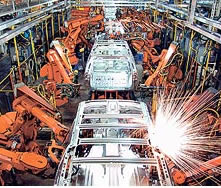Information Technology in the Workplace
Much of the attention IT has garnered is due to its unique power and speed, the diversity of IT applications in the workplace, and its recent, pervasive presence. Although many definitions are possible, IT can be defined as capital equipment that makes extensive use of microelectronics and programmed instructions or software. IT systems are often flexible, reprogrammable, and automatic or self-acting. They can record, process, communicate, and react to vast amounts of information entered by users, received from the environment, or stored internally.
Prominent examples of IT specific to manufacturing and similar blue collar jobs include numerically controlled and computer numerically controlled machine tools,
- robots,
- computerized diagnostic and testing equipment,
- manufacturing process controls such as programmable logic controllers,
- automated material handling equipment, automated guided vehicles,
- factory local area networks (LANs),
- computer-aided design and manufacturing (CAD/CAM),
- material resource planning software to manage supplies and inventory,
- flexible manufacturing systems that integrate many of these technologies into more fully automated systems.

Prominent information technology applications in office and service sector environments include
- common desktop applications such as word processors, spreadsheets, databases, e-mail clients,
- and Internet browsers;
- data entry and transactions processing systems (e.g., payroll, billing, bank transactions, and insurance claims);
- LANs;
- CAD;
- automatic teller machines;
- bank networks for electronic funds transfer;
- electronic data interchange for automated ordering and payment between purchasers and suppliers;
- barcode scanners; and
- point-of-sale devices.


Survey data indicate that the share of workers using computers with video screens and keyboard input on the job has increased tremendously. Popular applications include word processors, database and spreadsheet programs, and, more recently, e-mail clients and Internet browsers. Much less systematic data exist on most of the other applications noted above.




